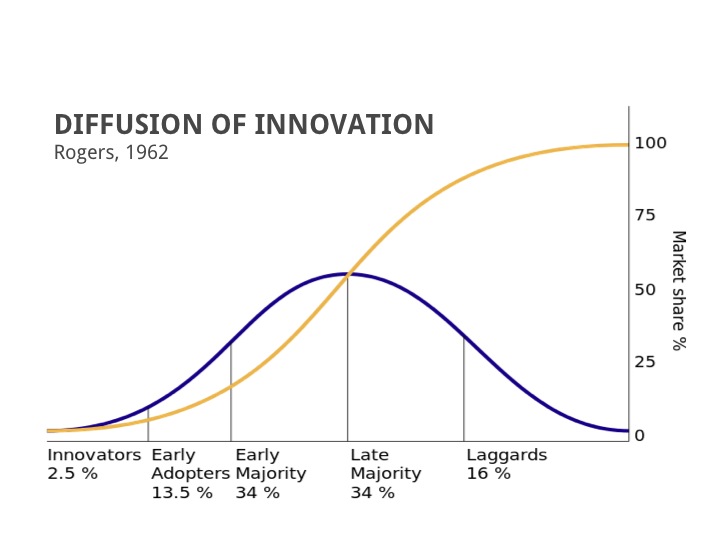Have you ever wondered how a new fashion trend spreads like wildfire, or how a song from a small town ends up topping the charts? The answer lies in a fascinating social phenomenon called diffusion. Diffusion, in its simplest form, is the process through which ideas, innovations, and cultural practices spread from one place to another, influencing and shaping societies along the way. But it’s more than just a simple transfer; it’s a dynamic interplay of social interactions, cultural influences, and individual choices.

Image: www.tandfonline.com
Imagine walking into a coffee shop and noticing everyone sporting a new type of coffee mug. You might be curious about it, and if you see others enjoying it, you might be tempted to try it yourself. This is diffusion in action. You’re witnessing the spread of a new trend, driven by curiosity, social influence, and perhaps a bit of “keeping up with the Joneses.”
The Many Facets of Diffusion in Social Studies
Defining Diffusion and Its Significance
Diffusion in social studies refers to the process by which an innovation, idea, or practice spreads across a population or geographical area. It’s not just about the physical movement of things, but also the adoption of new beliefs, behaviors, and technologies. It’s a vital concept in understanding how cultures change, societies evolve, and global interconnectedness emerges.
Types of Diffusion
Diffusion can occur through various pathways, each with its own dynamics. We can categorize them into:
- Expansion Diffusion: Here, the innovation spreads outward from a central point, similar to ripples in a pond. This can be further divided into:
- Contagious Diffusion: Spreading directly through contact, like a disease or a viral video.
- Hierarchical Diffusion: Spreading from influential nodes or centers, like fashion trends starting in major cities.
- Stimulus Diffusion: Spreading a basic idea, even if the specific innovation doesn’t adopt fully, like the spread of smartphone technology leading to different local innovations.
- Relocation Diffusion: This involves the movement of people carrying a trait or innovation with them to new locations. Think of the spread of languages and culinary traditions through migration.

Image: diffusion-research.org
Factors Influencing Diffusion
The speed and extent of diffusion are influenced by a number of factors:
- Innovativeness: The perceived usefulness and attractiveness of the innovation.
- Social Networks: The strength of connections between individuals, allowing for rapid transmission of information.
- Cultural Barriers: Existing values, beliefs, and practices can either facilitate or hinder the adoption of new ideas.
- Communication and Media: Access to information and exposure to media influence the awareness and acceptance of innovations.
- Economic Factors: The cost of adopting innovations and the potential for economic benefits or losses significantly impact diffusion.
Contemporary Diffusion: The Impact of Modern Technology
The 21st century has witnessed an unprecedented acceleration of diffusion fueled by technological advancements. Social media platforms, online marketplaces, and instant communication have dramatically shortened the distance and time it takes for ideas and innovations to reach global audiences.
Consider the rapid spread of viral challenges, political movements, and even social media-driven consumer trends. The internet and social networks have become powerful channels for expansion diffusion, allowing for rapid, contagious dissemination across geographical boundaries. This has profound implications for cultural exchange, social movements, and even global political landscapes.
Navigating the World of Diffusion: Tips and Insights
Understanding diffusion is vital for anyone involved in promoting ideas, navigating cultural change, or understanding social trends. Here are a few practical tips:
- Identify Your Target Audience: Who are you trying to reach with your idea or innovation? Tailor your message and your approach to resonate with their values, needs, and communication preferences.
- leverage Existing Networks: Harness the power of social networks and influencers to amplify your message and reach a wider audience. Consider collaborating with individuals or groups who already have established trust and engagement within your target audience.
- Be Open to Adaptation: Be prepared to adapt your innovation or idea to suit different cultural contexts and preferences. Flexibility and willingness to modify your approach can enhance the success of diffusion.
Remember, diffusion is a complex process shaped by individual choices, social dynamics, and cultural forces. By understanding the factors that influence its trajectory, we can navigate the ever-evolving landscape of ideas and innovations with greater awareness and effectiveness.
FAQ: Common Questions about Diffusion in Social Studies
Q: What is the difference between diffusion and globalization?
A: Globalization is a broader concept that encompasses the interconnectedness of societies through trade, communication, and cultural exchange. Diffusion is a more specific process within globalization, focusing on the spread of specific innovations, ideas, or practices.
Q: How does diffusion affect social change?
A: Diffusion is a driving force behind social change. When new ideas and innovations are adopted by societies, they can alter existing norms, values, and ways of life. This can lead to changes in behaviors, institutions, and even cultural identities.
Q: What are some examples of diffusion in modern society?
A: Examples include the global spread of smartphones, the popularity of K-pop music across continents, the adoption of online shopping, and the increasing awareness of environmental issues fueled by climate change activism.
Q: Is diffusion always a positive process?
A: While diffusion can bring about positive change through the spread of beneficial innovations and practices, it can also contribute to the transmission of negative phenomena, such as misinformation, violence, or cultural homogenization.
What Is Diffusion In Social Studies
Wrapping Up: Staying Aware in a World of Constant Change
Understanding diffusion helps us unpack the forces driving cultural evolution, technological advancement, and social change. It sheds light on how ideas and innovations connect us, shape our world, and impact our lives. By staying aware of these dynamics, we can actively participate in the spread of positive change and navigate a world characterized by constant change.
Are you interested in learning more about the fascinating world of diffusion and its impact on societies?





